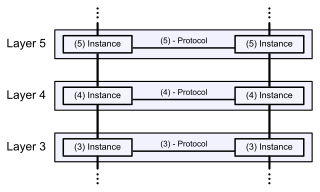The Internet protocol suite, commonly known as TCP/IP, is a framework for organizing the set of communication protocols used in the Internet and similar computer networks according to functional criteria. The foundational protocols in the suite are the Transmission Control Protocol (TCP), the User Datagram Protocol (UDP), and the Internet Protocol (IP). Early versions of this networking model were known as the Department of Defense (DoD) model because the research and development were funded by the United States Department of Defense through DARPA.

The Open Systems Interconnection model is a conceptual model that 'provides a common basis for the coordination of [ISO] standards development for the purpose of systems interconnection'. In the OSI reference model, the communications between a computing system are split into seven different abstraction layers: Physical, Data Link, Network, Transport, Session, Presentation, and Application.
Universal Plug and Play (UPnP) is a set of networking protocols that permits networked devices, such as personal computers, printers, Internet gateways, Wi-Fi access points and mobile devices to seamlessly discover each other's presence on the network and establish functional network services. UPnP is intended primarily for residential networks without enterprise-class devices.

Distributed Management Task Force (DMTF) is a 501(c)(6) nonprofit industry standards organization that creates open manageability standards spanning diverse emerging and traditional IT infrastructures including cloud, virtualization, network, servers and storage. Member companies and alliance partners collaborate on standards to improve interoperable management of information technologies.

In computing, the Preboot eXecution Environment, PXE specification describes a standardized client–server environment that boots a software assembly, retrieved from a network, on PXE-enabled clients. On the client side it requires only a PXE-capable network interface controller (NIC), and uses a small set of industry-standard network protocols such as DHCP and TFTP.

The RapidIO architecture is a high-performance packet-switched electrical connection technology. RapidIO supports messaging, read/write and cache coherency semantics. Based on industry-standard electrical specifications such as those for Ethernet, RapidIO can be used as a chip-to-chip, board-to-board, and chassis-to-chassis interconnect.
WS-Management is a DMTF open standard defining a SOAP-based protocol for the management of servers, devices, applications and various Web services. WS-Management provides a common way for systems to access and exchange management information across the IT infrastructure.
IEC 62056 is a set of standards for electricity metering data exchange by International Electrotechnical Commission.
The Common Information Model (CIM) is an open standard that defines how managed elements in an IT environment are represented as a common set of objects and relationships between them.
OPC Unified Architecture is a cross-platform, open-source, IEC62541 standard for data exchange from sensors to cloud applications developed by the OPC Foundation. Distinguishing characteristics are:
The Open Geospatial Consortium Web Coverage Service Interface Standard (WCS) defines Web-based retrieval of coverages – that is, digital geospatial information representing space/time-varying phenomena.
IEC 60870 part 6 in electrical engineering and power system automation, is one of the IEC 60870 set of standards which define systems used for telecontrol in electrical engineering and power system automation applications. The IEC Technical Committee 57 have developed part 6 to provide a communication profile for sending basic telecontrol messages between two systems which is compatible with ISO standards and ITU-T recommendations.
Content Management Interoperability Services (CMIS) is an open standard that allows different content management systems to inter-operate over the Internet. Specifically, CMIS defines an abstraction layer for controlling diverse document management systems and repositories using web protocols.
Data center bridging (DCB) is a set of enhancements to the Ethernet local area network communication protocol for use in data center environments, in particular for use with clustering and storage area networks.
Desktop and mobile Architecture for System Hardware (DASH) is a Distributed Management Task Force (DMTF) standard.
In computer networking, the link layer is the lowest layer in the Internet protocol suite, the networking architecture of the Internet. The link layer is the group of methods and communications protocols confined to the link that a host is physically connected to. The link is the physical and logical network component used to interconnect hosts or nodes in the network and a link protocol is a suite of methods and standards that operate only between adjacent network nodes of a network segment.
The Open Smart Grid Protocol (OSGP) is a family of specifications published by the European Telecommunications Standards Institute (ETSI) used in conjunction with the ISO/IEC 14908 control networking standard for smart grid applications. OSGP is optimized to provide reliable and efficient delivery of command and control information for smart meters, direct load control modules, solar panels, gateways, and other smart grid devices. With over 5 million OSGP based smart meters and devices deployed worldwide it is one of the most widely used smart meter and smart grid device networking standards.

The Application Portability Profile (APP) is a 1990s framework for Open-System Environment designed by the NIST for use by the U.S. Government. It contains a selected suite of specifications that defines the interfaces, services, protocols, and data formats for a particular class or domain of applications.
Jakarta Management is a Java specification request (JSR-77) for standardization of Jakarta EE server management. Jakarta Management abstracts the manageable parts of the Jakarta EE architecture and defines an interface for accessing management information. This helps system administrators integrate Jakarta EE servers into a system management environment and also helps application developers create their own management tools from scratch.
The Redfish standard is a suite of specifications that deliver an industry standard protocol providing a RESTful interface for the management of servers, storage, networking, and converged infrastructure.




